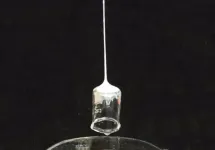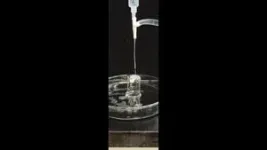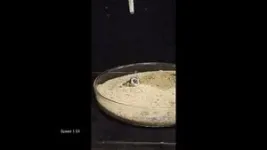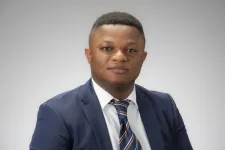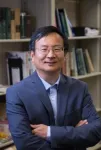(Press-News.org) Every kid who has read a comic book or watched a Spider-Man movie has tried to imagine what it would be like to shoot a web from their wrist, fly over streets, and pin down villains. Researchers at Tufts University took those imaginary scenes seriously and created the first web-slinging technology in which a fluid material can shoot from a needle, immediately solidify as a string, and adhere to and lift objects.
These sticky fibers, created at the Tufts University Silklab, come from silk moth cocoons, which are boiled in solution and broken down into their building block proteins called fibroin. The silk fibroin solution can be extruded through narrow bore needles to form a stream that, with the right additives, solidifies into a fiber when exposed to air.
Of course, nature is the original inspiration for deploying fibers of silk into tethers, webs, and cocoons. Spiders, ants, wasps, bees, butterflies, moths, beetles, and even flies can produce silk at some point in their lifecycle. Nature also inspired the Silklab to pioneer the use of silk fibroin to make powerful glues that can work underwater, printable sensors that can be applied to virtually any surface, edible coatings that can extend the shelf life of produce, a light collecting material that could significantly enhance the efficiency of solar cells, and more sustainable microchip manufacturing methods
However, while they made significant progress with silk-based materials, the researchers had yet to replicate the mastery of spiders, which can control the stiffness, elasticity, and adhesive properties of the threads they spin.
A breakthrough came about purely by accident. “I was working on a project making extremely strong adhesives using silk fibroin, and while I was cleaning my glassware with acetone, I noticed a web-like material forming on the bottom of the glass,” said Marco Lo Presti, research assistant professor at Tufts.
The accidental discovery overcame several engineering challenges to replicating spider threads. Silk fibroin solutions can slowly form a semi-solid hydrogel over a period of hours when exposed to organic solvents like ethanol or acetone, but the presence of dopamine, which is used in making the adhesives, allowed the solidification process to occur almost immediately. When the organic solvent wash was mixed in quickly, the silk solution rapidly created fibers with high tensile strength and stickiness. Dopamine and its polymers employ the same chemistry used by barnacles to form fibers that stick tenaciously to surfaces.
The next step was to spin the fibers in air. The researchers added dopamine to the silk fibroin solution, which appears to accelerate the transition from liquid to solid by pulling water away from the silk. When shot through a coaxial needle, a thin stream of the silk solution is surrounded by a layer of acetone which triggers the solidification. The acetone evaporates in mid-air, leaving a fiber attached to any object it contacted. The researchers enhanced the silk fibroin-dopamine solution with chitosan, a derivative of insect exoskeletons that gave the fibers up to 200 times greater tensile strength, and borate buffer, which increased their adhesiveness about 18-fold.
The diameter of the fibers could be varied between that of a human hair to about half a millimeter, depending on the bore of the needle.
The device can shoot fibers that can pick up objects over 80 times their own weight under various conditions. The researchers demonstrated this by picking up a cocoon, a steel bolt, a laboratory tube floating on water, a scalpel partially buried in sand, and a wood block from a distance of about 12 centimeters.
Lo Presti noted that “if you look at nature, you will find that spiders cannot shoot their web. They usually spin the silk out of their gland, physically contact a surface, and draw out the lines to construct their webs. We are demonstrating a way to shoot a fiber from a device, then adhere to and pick up an object from a distance. Rather than presenting this work as a bio-inspired material, it’s really a superhero-inspired material.”
Natural spider silk is still about 1000 times stronger than the man-made fibers in this study. But with a little added imagination and engineering, the innovation will continue to improve and pave the way for a variety of technological applications.
“As scientists and engineers, we navigate the boundary between imagination and practice. That’s where all the magic happens,” said Fiorenzo Omenetto, Frank C. Doble Professor of Engineering at Tufts University and director of the Silklab. “We can be inspired by nature. We can be inspired by comics and science fiction. In this case, we wanted to reverse engineer our silk material to behave the way nature originally designed it, and comic book writers imagined it.”
END
Inspired by Spider-Man, a lab recreates web-slinging technology
The stream of liquid silk quickly turns to a strong fiber that sticks to and lifts objects (although not yet villains)
2024-10-10
ELSE PRESS RELEASES FROM THIS DATE:
Applied Microbiology International’s 2024 Honorary Fellowship goes to Dr Chikwe Ihekweazu
2024-10-10
Applied Microbiology International (AMI) is delighted to announce that its 2024 Honorary Fellowship goes to Dr Chikwe Ihekweazu, who is Assistant Director General at the World Health Organization (WHO), leading the WHO Hub for Pandemic and Epidemic Intelligence.
AMI Honorary Fellowships are given to individuals who have made an outstanding contribution to or impact on the field of applied microbiology. Honorary Fellows of AMI are nominated and chosen each year by the organisation’s membership.
Chikwe ...
Pitt scientists validate new lab test platform for blood biomarkers of Alzheimer's disease
2024-10-10
University of Pittsburgh scientists independently validated a new blood test platform that can simultaneously measure more than a hundred biomarkers of Alzheimer's disease. The platform might improve clinicians’ ability to capture the multifaceted nature of Alzheimer’s pathology and streamline early disease diagnostics. The report was published in Molecular Neurodegeneration today.
“Alzheimer’s disease should not be looked at through one single lens,” said senior author Thomas Karikari, Ph.D., M.Sc., assistant professor of psychiatry at Pitt. “Capturing aspects of Alzheimer’s pathology in a panel of clinically validated biomarkers would increase ...
No bolts about it: New technology improves structural strength
2024-10-09
In a collaborative effort between Texas A&M University and Sandia National Laboratories, researchers have significantly improved a new joining technology, interlocking metasurfaces (ILMs), designed to increase the strength and stability of a structure in comparison to traditional techniques like bolts and adhesives, using shape memory alloys (SMAs). ILMs offer the potential to transform mechanical joint design in manufacturing for aerospace, robotics and biomedical devices.
“ILMs are poised to redefine joining technologies ...
Medical professionals must lead the fight against climate misinformation
2024-10-09
Medical professionals have a responsibility to lead the fight against climate misinformation to ensure that the public is well informed about the health risks posed by climate change, say experts in The BMJ today.
Misinformation (inaccurate information spread without malicious intent) and disinformation (deliberately deceptive information) in health is not new, write Professor Andy Haines and colleagues.
Just as the rapid spread of false information during the covid-19 pandemic undermined public trust in science and public health interventions, false information also pervades the climate change debate, influencing public perception and ...
Should doctors be suspended for unlawful climate activism?
2024-10-09
Former GP Sarah Benn was suspended by the medical practitioners tribunal service (MPTS) after an arrest for her involvement in climate protests. In The BMJ today, two experts debate the question of when and whether doctors in such cases should be sanctioned.
The recent case of Sarah Benn has sparked debate, partly because of a perception that the GMC referred her to a MPTS tribunal for taking part in peaceful protests, says Andrew Hoyle, assistant director at the GMC.
In reality, he explains ...
Extreme rainfall linked to heightened risk of death
2024-10-09
Extreme rainfall events are associated with an increased risk of death from all causes as well as from heart and lung diseases, finds an analysis of data from 34 countries and regions published by The BMJ today.
The health effects of extreme rainfall varied by local climate and vegetation coverage, providing a global perspective on the effect of extreme rainfall events on health.
Climate change is intensifying the frequency and severity of short term rainfall events, and emerging evidence suggests a compelling link between rainfall events and adverse health outcomes, particularly transmission ...
New research highlights the overlooked dangers of subtle and covert abuse in intimate relationships
2024-10-09
Peer-reviewed – Scoping Review - People
New research from the University of East Anglia has uncovered a significant gap in understanding of a harmful form of domestic abuse known as subtle or covert abuse.
Unlike more obvious forms of physical or verbal abuse, subtle abuse is less visible but can be just as damaging to victims.
The review found that current research on this topic is limited, despite its potentially widespread impact.
The findings suggest that subtle abuse ...
Snowflake dance analysis could improve rain forecasts
2024-10-09
The key to more accurate rainfall predictions may lie in the intricate dance of falling snowflakes, a new study has found.
The research, observing the physical motion of falling ice crystals, will help scientists better estimate where and when these crystals will melt into raindrops, a crucial stage in the formation of many types of rain.
Published today (Thursday 10 October) in the journal Atmospheric Chemistry and Physics, the study involved scientists watching how fake snowflakes fell in a substance ...
ASPB welcomes Hong Ma as Society President
2024-10-09
ASPB is delighted to welcome its new President, Hong Ma, who was elected in 2023 as President-elect and served in this role starting October 1, 2023. He stepped into his role as ASPB President on October 1, 2024 following the end of now-Past President Leeann Thornton’s term.
“A top priority is to support and train young plant biologists toward becoming members of a community with greater diversity, to amplify the voices of diverse members of our society, and to promote diversity and representation in society leadership and society activities,” ...
Can advanced AI can solve visual puzzles and perform abstract reasoning?
2024-10-09
Artificial Intelligence has learned to master language, generate art, and even beat grandmasters at chess. But can it crack the code of abstract reasoning—those tricky visual puzzles that leave humans scratching their heads? Researchers at USC Viterbi School of Engineering Information Sciences Institute (ISI) are putting AI’s cognitive abilities to the test, pushing the multi-modal large language models (MLLMs) to solve visual problems once reserved for human IQ tests. The result? A glimpse into how far AI has come—and where it still stumbles.
USC Viterbi ISI Research ...
LAST 30 PRESS RELEASES:
Quantum ‘alchemy’ made feasible with excitons
‘Revoice’ device gives stroke patients their voice back
USF-led study: AI helps reveal global surge in floating algae
New method predicts asthma attacks up to five years in advance
Researchers publish first ever structural engineering manual for bamboo
National poll: Less than half of parents say swearing is never OK for kids
Decades of suffering: Long-term mental health outcomes of Kurdish chemical gas attacks
Interactional dynamics of self-assessment and advice in peer reflection on microteaching
When aging affects the young: Revealing the weight of caregiving on teenagers
Can Canada’s health systems handle increased demand during FIFA World Cup?
Autistic and non-autistic faces may “speak a different language” when expressing emotion
No clear evidence that cannabis-based medicines relieve chronic nerve pain
Pioneering second-order nonlinear vibrational nanoscopy for interfacial molecular systems beyond the diffraction limit
Bottleneck in hydrogen distribution jeopardises billions in clean energy
Lung cancer death rates among women in Europe are finally levelling off
Scientists trace microplastics in fertilizer from fields to the beach
The Lancet Obstetrics, Gynecology, & Women’s Health: Taking paracetamol during pregnancy does not increase risk of autism, ADHD or intellectual disabilities, confirms new gold-standard evidence review
Taking paracetamol during pregnancy does not increase risk of autism, ADHD or intellectual disabilities
Harm reduction vending machines in New York State expand access to overdose treatment and drug test strips, UB studies confirm
University of Phoenix releases white paper on Credit for Prior Learning as a catalyst for internal mobility and retention
Canada losing track of salmon health as climate and industrial threats mount
Molecular sieve-confined Pt-FeOx catalysts achieve highly efficient reversible hydrogen cycle of methylcyclohexane-toluene
Investment in farm productivity tools key to reducing greenhouse gas
New review highlights electrochemical pathways to recover uranium from wastewater and seawater
Hidden pollutants in shale gas development raise environmental concerns, new review finds
Discarded cigarette butts transformed into high performance energy storage materials
Researchers highlight role of alternative RNA splicing in schizophrenia
NTU Singapore scientists find new way to disarm antibiotic-resistant bacteria and restore healing in chronic wounds
Research suggests nationwide racial bias in media reporting on gun violence
Revealing the cell’s nanocourier at work
[Press-News.org] Inspired by Spider-Man, a lab recreates web-slinging technologyThe stream of liquid silk quickly turns to a strong fiber that sticks to and lifts objects (although not yet villains)
